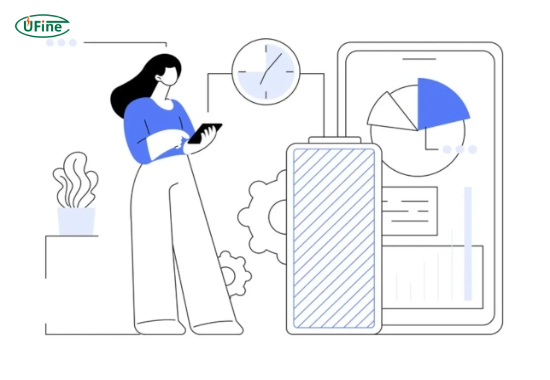How do you calculate battery run time? In this guide, we’ll cover how to calculate battery run time, understand the factors that influence it, and introduce a battery run time formula calculator for your devices.
Part 1. What does battery run time mean?
Battery run time refers to the duration for which a battery can power a device continuously before needing to be recharged or replaced. It is how long a device can operate on a single battery charge.
For example, suppose a smartphone has a battery run time of 10 hours. In that case, the device can operate for 10 hours under normal usage conditions before requiring a recharge. Understanding battery run time allows users to manage their device usage effectively, mainly when access to power sources is limited or unavailable.
Part 2. How to calculate battery run time easily?
To calculate battery run time, you need to follow a simple formula that considers the battery’s capacity and the power consumption of the device it powers.
Battery run time can be calculated using the following simple formula:
- Battery Run Time (in hours) = Battery Capacity (in mAh or Wh) / Device Power Consumption (in mA or W)
For instance, if you have a 3000mAh battery and the device uses 100mA, the run time would be:
Run Time = 3000mAh / 100mA = 30 hours
- Determine Battery Capacity: First, find out the capacity of the battery. Typically, people measure battery capacity in milliampere-hours (mAh) or watt-hours (Wh). You can generally find this information on the battery or the device’s specifications.
- Identify Device Power Consumption: Next, determine the power consumption of the device that the battery powers. Typically, people measure battery power consumption in watts (W) or milliamps (mA). You may need to consult the device’s user manual or specifications for this information.
- Apply the Formula: Once you have the battery capacity and device power consumption, you can calculate battery run time.
Part 3. Understanding the battery run time formula
The battery run time formula relies on understanding the relationship between amperes (amps), watts, and volts. Here’s a brief explanation of how these units are related:
Amperes (A): Amperes represent the rate of electrical flow in a circuit. It measures the amount of electric charge passing through a point in the circuit per unit of time.
Formula: I = Q / t
Where:
- I = Current (in amperes)
- Q = Electric charge (in coulombs)
- t = time (in seconds)
Volts (V): Volts indicate the electrical potential difference between two points in a circuit. It represents the force or pressure that drives the electric current.
Formula: V = W / Q
Where:
- V = Voltage (in volts)
- W = Work done (in joules)
- Q = Electric charge (in coulombs)
Watts (W): Watts measure a circuit’s energy transfer or consumption rate. It represents the amount of work done per unit of time.
Formula: P = V * I
Where:
- P = power (in watts)
- V = Voltage (in volts)
- I = Current (in amperes)
Part 4. Battery run time calculation examples
Here are case studies demonstrating how to calculate battery run time for various devices and scenarios:
Example 1: Power Tool
- Battery Capacity: 4000mAh
- Device Power Consumption: 500mA
To calculate the battery run time:
Battery Run Time (in hours) = Battery Capacity (in mAh) / Device Power Consumption (in mA)
= 4000mAh / 500mA
= 8 hours
In this scenario, a power tool with a battery capacity 4000mAh and a power consumption of 500mA can operate continuously for approximately 8 hours on a single charge.
Example 2: Laptop
- Battery Capacity: 5000mAh
- Device Power Consumption: 1A (1000mA)
To calculate the battery run time:
Battery Run Time (in hours) = Battery Capacity (in mAh) / Device Power Consumption (in mA)
= 5000mAh / 1000mA
= 5 hours
For a laptop with a capacity of 5000mAh and power consumption of 1A (1000mA), the battery can last about 5 hours before recharging.
Example 3: Smartphone (Connected to Wh and V)
- Battery Capacity: 3000mAh (or 3Ah)
- Device Power Consumption: 200mA (or 0.2A)
- Battery Voltage: 3.7V (typical for lithium-ion smartphone batteries)
To calculate the battery capacity in watt-hours (Wh):
Battery Capacity (in Wh) = Battery Capacity (in Ah) * Battery Voltage (in V)
= 3Ah * 3.7V
= 11.1Wh
Now, using the battery run time formula:
Battery Run Time (in hours) = Battery Capacity (in mAh) / Device Power Consumption (in mA)
= 3000mAh / 200mA
= 15 hours
Example 4: Flashlight (Connected to mA and mAh)
- Battery Capacity: 1000mAh (or 1Ah)
- Device Power Consumption: 50mA (or 0.05A)
We need to know the Voltage to calculate the battery capacity in watt-hours (Wh). Let’s assume a standard voltage for flashlight batteries, such as 1.5V:
Battery Capacity (in Wh) = Battery Capacity (in Ah) * Battery Voltage (in V)
= 1Ah * 1.5V
= 1.5Wh
Now, using the battery run time formula:
Battery Run Time (in hours) = Battery Capacity (in mAh) / Device Power Consumption (in mA)
= 1000mAh / 50mA
= 20 hours
These examples showcase how to apply different units and formulas to calculate device battery run time.
Example 5: Solar Panel Battery
- Battery Capacity: 150Ah
- Device Power Consumption: 300W
To calculate the battery run time for a solar panel system, we use the formula:
Battery Run Time (in hours) = Battery Capacity (in Ah) / Device Power Consumption (in W)
= 150Ah / 300W = 0.5 hours
This solar panel battery would last for approximately 30 minutes when powering a 300W device. However, this calculation can vary based on the solar panel’s output and sunlight hours.
Part 5. Factors influencing battery run time
Battery Capacity
The capacity of the battery, typically measured in milliampere-hours (mAh) or watt-hours (Wh), directly impacts its run time. A higher-capacity battery can provide longer run times compared to a lower-capacity one.
Device Power Consumption
The device connected to the battery determines how quickly it will deplete based on its power consumption. Devices with higher power consumption rates drain the battery faster, resulting in shorter run times.
Battery Age
As batteries age, their capacity diminishes, leading to shorter run times. Factors such as the number of charge cycles, temperature exposure, and overall usage patterns contribute to battery degradation over time.
Temperature
Battery performance is sensitive to temperature. Both extreme heat and cold can affect battery efficiency, leading to reduced run times.
To ensure optimal performance, keep devices within recommended temperature ranges. This will help maintain battery capacity and extend run time.
Usage Patterns
The way users significantly use the device impacts battery run time. Intensive tasks such as gaming or video streaming consume more power and shorten run times compared to lighter tasks like browsing or reading.
Screen Brightness and Connectivity
Settings like screen brightness level and connectivity options (Wi-Fi, Bluetooth, GPS) affect power consumption. Higher screen brightness and active connectivity features drain the battery faster, reducing run times.
Background Processes
Background apps and processes running on the device consume power even when not in use, affecting battery run time. Closing unnecessary apps and minimizing background processes can conserve battery life.
Battery Chemistry
Different battery chemistries, such as lithium-ion (Li-ion) or nickel-metal hydride (NiMH), have varying energy densities and discharge characteristics, influencing battery run time.
In the conclusion
Now that you know how to calculate battery run time and factors affecting it, use our battery life calculator to estimate your device’s battery performance.
Part 7. FAQs
-
How long will A 100ah battery last calculator?
To calculate how long a 100Ah battery will last, divide its capacity (100Ah) by the device’s current draw. -
How long will A 100ah battery run an appliance that requires 400w?
To determine the runtime of a 100Ah battery for a 400W appliance, divide the battery’s capacity (100Ah) by the appliance’s power consumption (400W). -
How do you calculate solar battery run time?
To calculate solar battery runtime, divide the battery’s capacity by the power consumption of the connected devices and consider factors like solar panel output and sunlight hours. -
How do you calculate battery run time for the inverter?
Calculate battery runtime for an inverter by dividing the battery’s capacity by the power consumption of the inverter and connected devices, factoring in inefficiencies and battery voltage. -
How do battery type and chemistry affect run time?
Battery chemistries like lithium-ion and nickel-metal hydride have different energy densities, which can affect their run time in devices. Li-ion batteries, for instance, typically offer longer run times due to their higher energy density. -
How can temperature affect battery performance?
Extreme temperatures, both hot and cold, can reduce a battery’s capacity and efficiency, leading to shorter run times. Devices should be used within recommended temperature ranges for optimal performance.
Related Tags:
More Articles

Paper Battery vs. Flexible Battery: What’s the Difference and Which Is Better?
Paper vs. flexible batteries: learn the key differences, benefits, and which power source fits best for wearables, sensors, and smart tech.
What to Know Before Buying a Tiny LiPo Battery for Your Project
Tiny LiPo batteries are powerful and compact. Learn how to choose the right one for your project with specs, safety, and charging tips.
Bloated LiPo Battery: Will It Explode?
Will a bloated LiPo battery explode? Discover the causes, risks, safety steps, and expert tips to avoid disaster and protect your gear. Must-read safety guide!
12V 100Ah Lithium Ion Battery Price: Full Guide
Learn about 12V 100Ah lithium-ion battery price, from cost ranges to best brands, hidden fees, and how to get the best deal. A must-read for smart buyers!
Resistance and Conductivity: What It Means for Your Lithium Batteries
Resistance and conductivity impact lithium battery performance, lifespan, and safety—learn how they work and why they matter.






